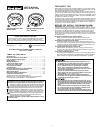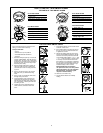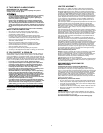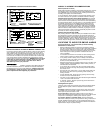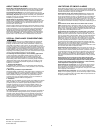
AGENCY PLACEMENT RECOMMENDATIONS
NFPA 72 (National Fire Code)
Smoke Alarms shall be installed in each separate sleeping room, outside
each sleeping area in the immediate vicinity of the bedrooms and on
each additional story of the family living unit, including basements and
excluding crawl spaces and unfinished attics.
In new construction, Alarms shall be so arranged that operation of any
one Alarm shall cause the operation of all Alarms within the dwelling.
Smoke Detection-Are More Smoke Alarms Desirable? The required
number of Smoke Alarms might not provide reliable early warning pro-
tection for those areas separated by a door from the areas protected by
the required Smoke Alarms. For this reason, it is recommended that the
householder consider the use of additional Smoke Alarms for those
areas for increased protection. The additional areas include the base-
ment, bedrooms, dining room, furnace room, utility room, and hallways
not protected by the required Smoke Alarms. The installation of Smoke
Alarms in kitchens, attics (finished or unfinished), or garages is not nor-
mally recommended, as these locations occasionally experience condi-
tions that can result in improper operation.
California State Fire Marshal (CSFM)
Early warning detection is best achieved by the installation of fire detec-
tion equipment in all rooms and areas of the household as follows: A
Smoke Alarm installed in each separate sleeping area (in the vicinity, but
outside bedrooms), and Heat or Smoke Alarms in the living rooms, din-
ing rooms, bedrooms, kitchens, hallways, finished attics, furnace rooms,
closets, utility and storage rooms, basements, and attached garages.
LOCATIONS TO AVOID FOR SMOKE ALARMS
For best performance, it is recommended you AVOID installing
Smoke Alarms in these areas:
• Where combustion particles are produced. Combustion particles
form when something burns. Areas to avoid include poorly ventilated
kitchens, garages, and furnace rooms. Keep units at least 20 feet
(6 meters) from the sources of combustion particles (stove, furnace,
water heater, space heater) if possible. Ventilate these areas as
much as possible.
• In air streams near kitchens. Air currents can draw cooking smoke
into the sensing chamber of a Smoke Alarm near the kitchen.
• In very damp, humid or steamy areas, or directly near bathrooms
with showers. Keep units at least 10 feet (3 meters) away from
showers, saunas, dishwashers, etc.
• Where the temperatures are regularly below 40˚ F (4˚C) or above 100˚
F (38˚C), including unheated buildings, outdoor rooms, porches, or
unfinished attics or basements.
• In very dusty, dirty, or greasy areas. Do not install a Smoke Alarm
directly over the stove or range. Keep laundry room Smoke Alarms
free of dust or lint.
• Near fresh air vents, ceiling fans, or in very drafty areas. Drafts can
blow smoke away from the unit, preventing it from reaching the
sensing chamber.
• In insect infested areas. Insects can clog openings to the sensing
chamber and cause unwanted alarms.
• Less than 12 inches (305mm) away from fluorescent lights. Electrical
“noise” can interfere with the sensor.
• In “dead air” spaces. “Dead air” spaces may prevent smoke from
reaching the Smoke Alarm.
Avoiding Dead Air Spaces
“Dead air” spaces may prevent smoke from reaching the Smoke Alarm.
To avoid dead air spaces, follow the installation recommendations
below.
On ceilings, install Smoke Alarms as close to the center of the ceiling
as possible. If this is not possible, install the Smoke Alarm at least 4
inches (102 mm) from the wall or corner.
For wall mounting (if allowed by building codes), the top edge of
Smoke Alarms should be placed between 4 and 12 inches (102 and 305
mm) from the wall/ceiling line, below typical “dead air” spaces.
On a peaked, gabled, or cathedral ceiling, install the first Smoke
Alarm within 3 feet (0.9 meters) of the peak of the ceiling, measured hor-
izontally. Additional Smoke Alarms may be required depending on the
length, angle, etc. of the ceiling's slope. Refer to NFPA 72 for details on
requirements for sloped or peaked ceilings.
BEDROOM
BEDROOM
HALL
LIVING ROOM KITCHEN
FINISHED BASEMENT
BEDROOM
BEDROOM
LIVING ROOM
DINING ROOM
MULTI-STORY RESIDENCE
SINGLE-STORY RESIDENCE, APARTMENT,
MOBILE HOME
EXISTING HOMES
KITCHEN
REQUIRED TO
MEET NFPA
RECOMMENDATIONS
RECOMMENDED
FOR ADDITIONAL
PROTECTION
KEY:
SMOKE ALARMS WITH SILENCE
FEATURES RECOMMENDED FOR
ADDITIONAL PROTECTION
INTERCONNECTED
AC OR AC/DC
SMOKE ALARMS
BEDROOM
BEDROOM
HALL
LIVING ROOM KITCHEN
FINISHED BASEMENT
REQUIRED TO
MEET NFPA
RECOMMENDATIONS
RECOMMENDED
FOR ADDITIONAL
PROTECTION
BEDROOM
BEDROOM
LIVING ROOM
DINING ROOM
MULTI-STORY RESIDENCE
SINGLE-STORY RESIDENCE, APARTMENT,
MOBILE HOME
KEY:
NEW CONSTRUCTION
SMOKE ALARMS
WITH SILENCE
FEATURES
RECOMMENDED
FOR ADDITIONAL
PROTECTION
KITCHEN
RECOMMENDED LOCATIONS FOR SMOKE ALARMS
INSTALLING SMOKE ALARMS IN MOBILE HOMES & RVS
For minimum security install one Smoke Alarm as close to each sleeping
area as possible. For more security, put one unit in each room. Many
older mobile homes (especially those built before 1978) have little or no
insulation. If your mobile home is not well insulated, or if you are unsure
of the amount of insulation, it is important to install units on inside walls
only. Smoke Alarms should be installed where temperatures normally
remain between 40˚F (4˚C) and 100˚F (38˚C). WARNING: Test units used
in RVs after the vehicle has been in storage, before every trip, and
once a week while in use. Failure to test units used in RVs as
described may remove your protection.
This equipment should be installed in accordance with NFPA (National Fire
Protection Association) 72 and
101. National Fire Protection Association,
One Batterymarch Park, Quincy, MA 02269-9101. Additional local build-
ing and regulatory codes may apply in your area. Always check com-
pliance requirements before beginning any installation.
5



